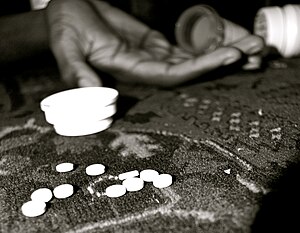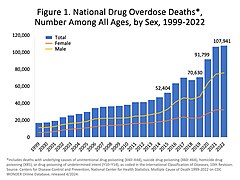Drug Overdose
A drug overdose (overdose or OD) is the ingestion or application of a drug or other substance in quantities much greater than are recommended.
Typically it is used for cases when a risk to health will potentially result. An overdose may result in a toxic state or death.
| Drug overdose | |
|---|---|
| Other names | Overdose, OD, Hotshot, Wasted, Intoxication, Gassed, Medicinal Poisoning |
 | |
| A photograph showing a person who had overdosed | |
| Specialty | Toxicology |
| Symptoms | Vary depending on the drug and the amount used |
| Complications |
|
| Causes |
|
| Risk factors | |
| Differential diagnosis | |
| Treatment | |

Classification

The word "overdose" implies that there is a common safe dosage and usage for the drug; therefore, the term is commonly applied only to drugs, not poisons, even though many poisons as well are harmless at a low enough dosage. Drug overdose is sometimes used as a means to commit suicide, as the result of intentional or unintentional misuse of medication. Intentional misuse leading to overdose can include using prescribed or non-prescribed drugs in excessive quantities in an attempt to produce euphoria.
Usage of illicit drugs, in large quantities, or after a period of drug abstinence can also induce overdose. Cocaine and opioid users who inject intravenously can easily overdose accidentally, as the margin between a pleasurable drug sensation and an overdose is small. Unintentional misuse can include errors in dosage caused by failure to read or understand product labels. Accidental overdoses may also be the result of over-prescription, failure to recognize a drug's active ingredient or unwitting ingestion by children. A common unintentional overdose in young children involves multivitamins containing iron.
The term 'overdose' is often misused as a descriptor for adverse drug reactions or negative drug interactions due to mixing multiple drugs simultaneously.
Signs and symptoms
| Symptoms | Blood pressure | Heart rate | Respiratory rate | Temperature | Pupils | Bowel sounds | Diaphoresis |
|---|---|---|---|---|---|---|---|
| Anticholinergic | ~ [clarification needed] | up | ~ | up | dilated | down | down |
| Cholinergic | ~ | ~ | unchanged | unchanged | constricted | up | up |
| Opioid | down | down | down | down | constricted | down | down |
| Sympathomimetic | up | up | up | up | dilated | up | up |
| Sedative-hypnotic | down | down | down | down | ~ | down | down |
Signs and symptoms of an overdose vary depending on the drug or exposure to toxins. The symptoms can often be divided into differing toxidromes. This can help one determine what class of drug or toxin is causing the difficulties.
Symptoms of opioid overdoses include slow breathing, heart rate and pulse. Opioid overdoses can also cause pinpoint pupils, and blue lips and nails due to low levels of oxygen in the blood. A person experiencing an opioid overdose might also have muscle spasms, seizures and decreased consciousness. A person experiencing an opiate overdose usually will not wake up even if their name is called or if they are shaken vigorously.
Causes
The drugs or toxins that are most frequently involved in overdose and death (grouped by ICD-10):
- Acute alcohol intoxication (F10)
- Opioid overdose (F11)
- Among sedative-hypnotics (F13)
- Barbiturate overdose (T42.3)
- Benzodiazepine overdose (T42.4)
- Uncategorized sedative-hypnotics (T42.6)
- Ethchlorvynol (Placidyl)
- GHB
- Glutethimide (Doriden)
- Methaqualone
- Ketamine (T41.2)
- Among stimulants (F14-F15)
- Cocaine overdose (T40.5)
- Amphetamine overdose (T43.6)
- Methamphetamine overdose (T43.6)
- Among tobacco (F17)
- Nicotine poisoning (T65.2)
- Among poly drug use (F19)
- Drug "cocktails" (speedballs)
- Medications
- Aspirin poisoning (T39.0)
- Paracetamol poisoning (Alone or mixed with oxycodone)
- Paracetamol toxicity (T39.1)
- Tricyclic antidepressant overdose (T43.0)
- Vitamin poisoning
- Pesticide poisoning (T60)
- Inhalants
- Lithium toxicity
Added flavoring
Masking undesired taste may impair judgement of the potency, which is a factor in overdosing. For example, lean is usually created as a drinkable mixture, the cough syrup is combined with soft drinks, especially fruit-flavored drinks such as Sprite, Mountain Dew or Fanta, and is typically served in a foam cup. A hard candy, usually a Jolly Rancher, may be added to give the mixture a sweeter flavor.
Diagnosis
The substance that has been taken may often be determined by asking the person. However, if they will not, or cannot, due to an altered level of consciousness, provide this information, a search of the home or questioning of friends and family may be helpful.
Examination for toxidromes, drug testing, or laboratory test may be helpful. Other laboratory test such as glucose, urea and electrolytes, paracetamol levels and salicylate levels are typically done. Negative drug-drug interactions have sometimes been misdiagnosed as an acute drug overdose, occasionally leading to the assumption of suicide.
Prevention
The distribution of naloxone to injection drug users and other opioid drug users decreases the risk of death from overdose. The Centers for Disease Control and Prevention (CDC) estimates that U.S. programs for drug users and their caregivers prescribing take-home doses of naloxone and training on its utilization are estimated to have prevented 10,000 opioid overdose deaths. Healthcare institution-based naloxone prescription programs have also helped reduce rates of opioid overdose in the U.S. state of North Carolina, and have been replicated in the U.S. military. Nevertheless, scale-up of healthcare-based opioid overdose interventions is limited by providers' insufficient knowledge and negative attitudes towards prescribing take-home naloxone to prevent opioid overdose. Programs training police and fire personnel in opioid overdose response using naloxone have also shown promise in the U.S.
Supervised injection sites (also known as overdose prevention centers) have been used to help prevent drug overdoses by offering opioid reversal medications such as naloxone, medical assistance and treatment options. They also provide clean needles to help prevent the spread of diseases like HIV/AIDS and hepatitis.
Management

Stabilization of the person's airway, breathing, and circulation (ABCs) is the initial treatment of an overdose. Ventilation is considered when there is a low respiratory rate or when blood gases show the person to be hypoxic. Monitoring of the patient should continue before and throughout the treatment process, with particular attention to temperature, pulse, respiratory rate, blood pressure, urine output, electrocardiography (ECG) and O2 saturation. Poison control centers and medical toxicologists are available in many areas to provide guidance in overdoses both to physicians and to the general public.
Antidotes
Specific antidotes are available for certain overdoses. For example, naloxone is the antidote for opiates such as heroin or morphine. Similarly, benzodiazepine overdoses may be effectively reversed with flumazenil. As a nonspecific antidote, activated charcoal is frequently recommended if available within one hour of the ingestion and the ingestion is significant. Gastric lavage, syrup of ipecac, and whole bowel irrigation are rarely used.
Epidemiology and statistics
The examples and perspective in this section may not represent a worldwide view of the subject. (December 2022) |

The UN gives a figure of 300,000 deaths per year in the world through drug overdose.
1,015,060 US residents died from drug overdoses from 1968 to 2019. 22 people out of every 100,000 died from drug overdoses in 2019 in the US. From 1999 to Feb 2019 in the United States, more than 770,000 people have died from drug overdoses.
In the US around 107,500 people died in the 12-month period ending August 31, 2022, at a rate of 294 deaths per day. 70,630 people died from drug overdoses in 2019. The U.S. drug overdose death rate has gone from 2.5 per 100,000 people in 1968 to 21.5 per 100,000 in 2019.
The National Center for Health Statistics reports that 19,250 people died of accidental poisoning in the U.S. in the year 2004 (eight deaths per 100,000 population).
In 2008 testimony before a Senate subcommittee, Leonard J. Paulozzi, a medical epidemiologist at the Centers for Disease Control and Prevention said that in 2005 more than 22,000 American people died due to overdoses, and the number is growing rapidly. Paulozzi also testified that all available evidence suggests unintentional overdose deaths are related to the increasing use of prescription drugs, especially opioid painkillers. However, the vast majority of overdoses are also attributable to alcohol. It is very rare for a victim of an overdose to have consumed just one drug. Most overdoses occur when drugs are ingested in combination with alcohol.
Drug overdose was the leading cause of injury death in 2013. Among people 25 to 64 years old, drug overdose caused more deaths than motor vehicle traffic crashes. There were 43,982 drug overdose deaths in the United States in 2013. Of these, 22,767 (51.8%) were related to prescription drugs.
The 22,767 deaths relating to prescription drug overdose in 2013, 16,235 (71.3%) involved opioid painkillers, and 6,973 (30.6%) involved benzodiazepines. Drug misuse and abuse caused about 2.5 million emergency department (ED) visits in 2011. Of these, more than 1.4 million ED visits were related to prescription drugs. Among those ED visits, 501,207 visits were related to anti-anxiety and insomnia medications, and 420,040 visits were related to opioid analgesics.
- U.S. yearly overdose deaths from all drugs.
- U.S. yearly overdose deaths involving benzodiazepines.
- U.S. yearly overdose deaths involving cocaine.
- U.S. yearly overdose deaths involving heroin.
- U.S. overdose deaths involving all opioids. Deaths per 100,000 population.
- U.S. yearly deaths involving prescription opioids. Non-methadone synthetics is a category dominated by illegally acquired fentanyl, and has been excluded.
- US yearly overdose deaths, and the drugs involved. Among the 70,200 deaths in 2017, the sharpest increase occurred among deaths related to fentanyl and fentanyl analogs (synthetic opioids) with 28,466 deaths.
See also
References
Further reading
- Nelson, Lewis H.; Flomenbaum, Neal; Goldfrank, Lewis R.; Hoffman, Robert Louis; Howland, Mary Deems; Neal A. Lewin (2015). Goldfrank's toxicologic emergencies. New York: McGraw-Hill, Medical Pub. Division. ISBN 978-0-07-143763-9.
- Olson, Kent C. (2004). Poisoning & drug overdose. New York: Lange Medical Mooks/McGraw-Hill. ISBN 0-8385-8172-2.
External links


This article uses material from the Wikipedia English article Drug overdose, which is released under the Creative Commons Attribution-ShareAlike 3.0 license ("CC BY-SA 3.0"); additional terms may apply (view authors). Content is available under CC BY-SA 4.0 unless otherwise noted. Images, videos and audio are available under their respective licenses.
®Wikipedia is a registered trademark of the Wiki Foundation, Inc. Wiki English (DUHOCTRUNGQUOC.VN) is an independent company and has no affiliation with Wiki Foundation.






